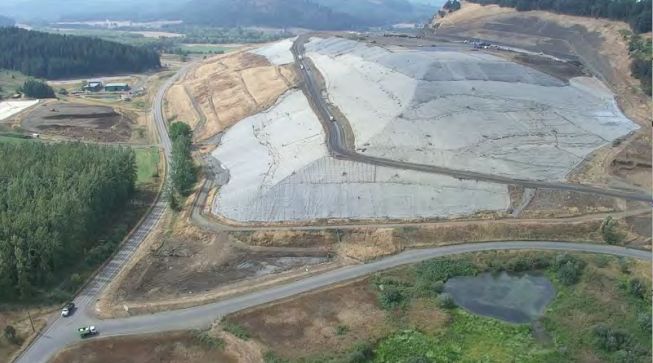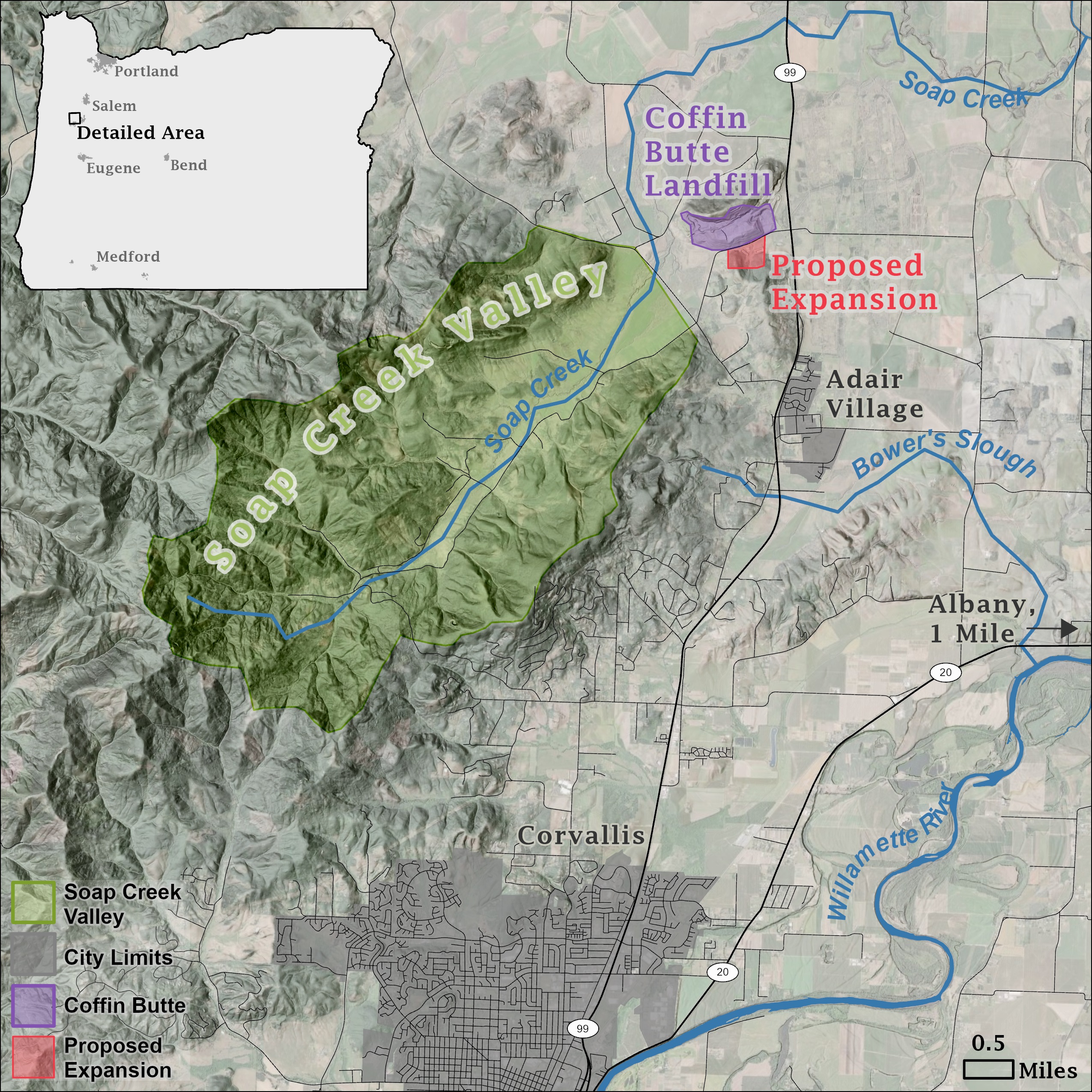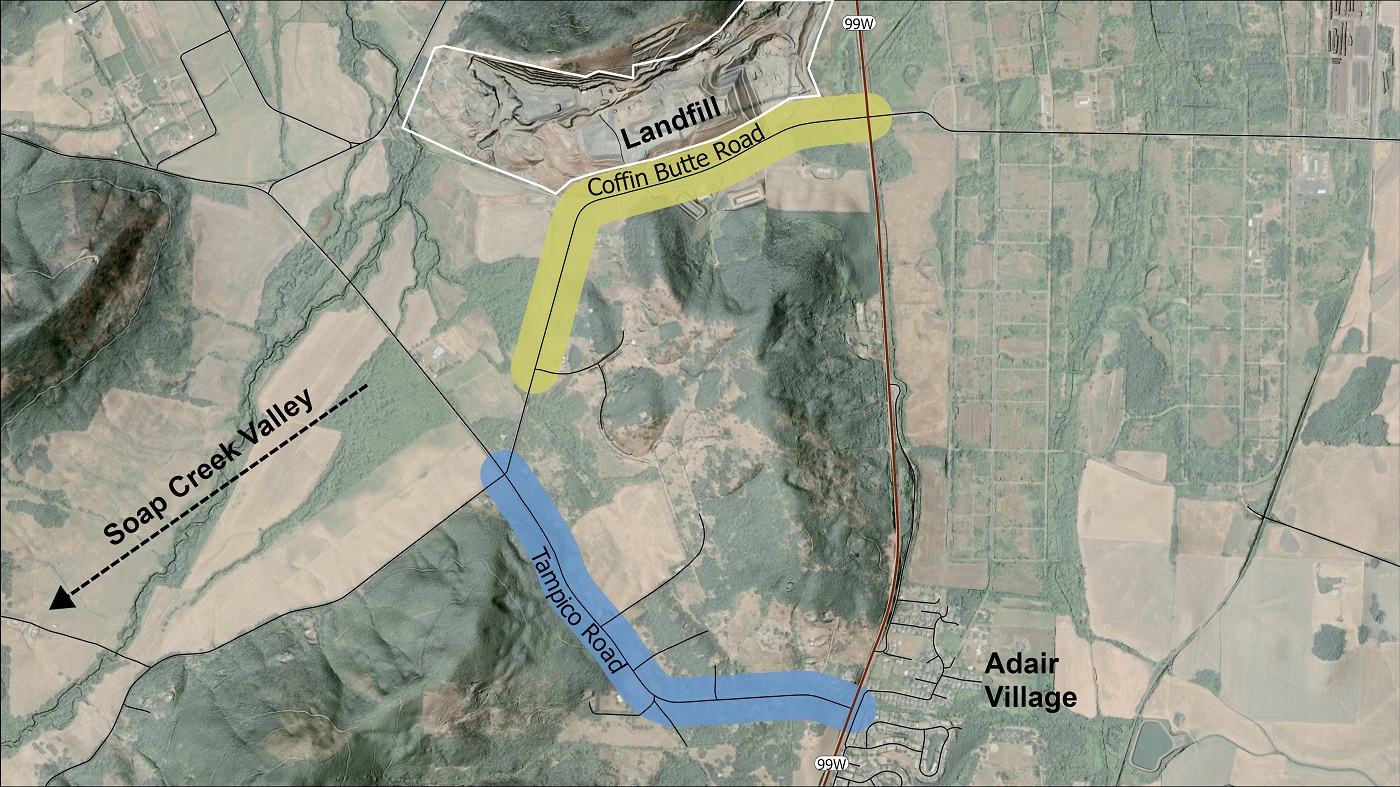Coffin Butte: A Mountain Full Of Trash
Breaking News
Coffin Butte is Filing for an Expansion of Landfill This Summer!
Coffin Butte is filing for an expansion this summer! Sign up for action alerts to stay up to date on opportunities for public comment. We will keep you posted on testimony support and ways to get involved.
NEWS:
Coffin Butte operator sets stage for second dump expansion attempt by Alex Powers, Corvallis Gazette-Times (Jun 21, 2024)
Coffin Butte Landfill near Corvallis will again try to expand; info meetings scheduled by Tracey Loew, Salem Statesman-Journal (June 26, 2024)

Aerial view of Coffin Butte Landfill
Coffin Butte Landfill first originated as a dumpsite for Adair Village, a World War II military airbase. After the war, the dump was taken over by a local family who ran the landfill business for several years until it was sold to Valley Landfills inc in 1975. In 2005, Valley Landfills Inc was purchased by Republic Services, the 2nd largest waste management company in the United States. Since then, the company has steadily increased the amount of trash landfilled each year, and imports trash from all over western and central Oregon in addition to a few out of state counties in Washington.

Coffin Butte is located about 5 miles north of Corvallis near the community of Adair Village. The landfill is Oregon’s 2nd largest landfill behind Columbia Ridge in Arlington, Oregon.
Future of Benton County and Coffin Butte Webinar Recording
Grassroots Opposition
In 2021, Republic Services applied to expand the area of the landfill by 30% and substantially increase their ability to add new areas to receive trash. In addition, their application contained a proposal to build the landfill site across Coffin Butte Road, essentially closing the primary ingress and egress for local residents. Facing the prospect of more garbage, closure of a critical road for fire evacuation, and the already burdensome air pollution from the existing facility, members of the Soap Creek Valley gathered to organize a resistance to the Coffin Butte Landfill Expansion. The newly formed Valley Neighbors for Environmental Quality and Safety or VNEQS, led a stiff grassroots resistance and increased community awareness around landfill issues. Their efforts substantially impacted Benton County’s decision to deny the Coffin Butte Expansion. Republic Services is attempting to expand again this year!

The 2021 proposed expansion to Coffin Butte Landfill would have resulted in the closure and demolition of Coffin Butte Road in order to make room to fill the area with landfilled garbage. Many residents of the Soap Creek Valley expressed concerns that closing one of the two main exits from the Valley to Highway 99 would make wildfire evacuation difficult and risky, especially if that fire were along the other exit route, Tampico Road.
Beyond Toxics and Coffin Butte Landfill
Communities around the Coffin Butte Landfill sought our assistance to help stop a plan to expand the landfill by 30% and understand the landfill's toxic impact. Collaborating with the community, our research uncovered alarming methane leaks and millions of gallons of landfill leachate containing high levels of PFAS discharged into the Willamette River every year. By filing public records requests with the State, we learned the Oregon DEQ has neglected to scrutinize and update Coffin Butte's air quality permit since it was issued in 2009, making it nearly 10 years out of date. We successfully filed complaints to prompt state and federal action for compliance. In addition to seeking lasting policy change, Beyond Toxics also hosted a community-wide town hall attended by over 80 people and canvassed over 400 homes in the community closest to the landfill to better understand the community's experience of living downwind from a large waste dump.
Coffin Butte's methane emissions contribute significantly to global warming. Addressing these leaks is vital in mitigating climate change risks. Additionally, ending the practice of leachate dumping in Oregon rivers is crucial for safeguarding drinking water, salmon, and aquatic ecosystems from harmful, bio-persistant pollutants like PFAS, the “forever chemical.”
Coffin Butte Landfill’s Methane Problem
In June 2022, the Environmental Protection Agency (EPA) performed an announced inspection of the Coffin Butte Landfill to ensure the facility was operating in compliance with methane emissions standards. Organic matter, for example food waste ,yard waste, wood products, non-synthetic cloths, produces methane as it decays. This is consequential for climate changes as methane is a greenhouse gas 84 times more powerful than carbon dioxide. By law, Oregon’s largest landfills are required to install gas control and collection systems. This involves tarping non-operational sections of the landfills to create an inescapable environment for methane, and using gas wells to pump methane into electricity generators or flares that burn off the methane prior to entering the atmosphere. Landfill operators are required to inspect the landfill for leaks four times a year and report any leaks to the Department of Environmental quality.
Despite landfill operators knowing the inspection was going to happen, and having an opportunity to make sure the facility was in full compliance with methane capture regulations, the EPA nonetheless found 61 methane leaks exceeding the allowable limit of 500 parts per million. The vast majority of leaks were well beyond that threshold--several reached and exceeded 50,000 parts per million, which could cause an explosion or fire with an ignition source. 23 of those leaks were located near gas collection wells that Oregon law requires operators to regularly inspect. The EPA's findings completely contradicted the report led by Valley Landfills, Inc. Only 14 days earlier. Valley Landfills, Inc. claimed they found a mere 6 leaks In their report, the EPA expressed numerous concerns over Coffin Butte's methane leaks monitoring techniques and their self-reported data to the Department of Environmental Quality.
A recent project by Carbon Mapper provides evidence that Coffin Butte landfill methane emissions are exceedingly large, much more serious than Coffin Butte has reported. We believe that methane monitoring conducted with sensitive instrumentation carried by fly-over aircraft is the best path forward for measuring, monitoring and reporting the impact of landfill methane emissions.
Worker Safety
Several workers and a union for mechanics have flagged safety concerns to regulators and Benton County Commissioners. Their concerns have cited expired personal protective equipment, lack of areas to wash hands and contaminated clothing, as well as unsafe practices for disposing of carcinogenic materials. The union went on strike in September 2023 and returned to work in November 2023 in order to provide for their families through the winter season. Employees have stated that little has been done to remedy their health and safety concerns as of March 2024.
Resources
8 Reasons to Oppose Expanding Coffin Butte (PDF)
Hechos de expansión de Coffin Butte (PDF)
NEWS:
Coffin Butte operator sets stage for second dump expansion attempt by Alex Powers, Corvallis Gazette-Times (Jun 21, 2024)
Coffin Butte Landfill workers allege safety and environmental violations
Yahoo News reprint of Statesman Journal article, April 16, 2024
Oregon cites Republic Services' Coffin Butte Landfill following worker complaints
Workers have been raising health and environment concerns for more than six months. The company denies the allegations - by Tracy Loew, Salem Statesman Journal
Back to Waste Management Projects





